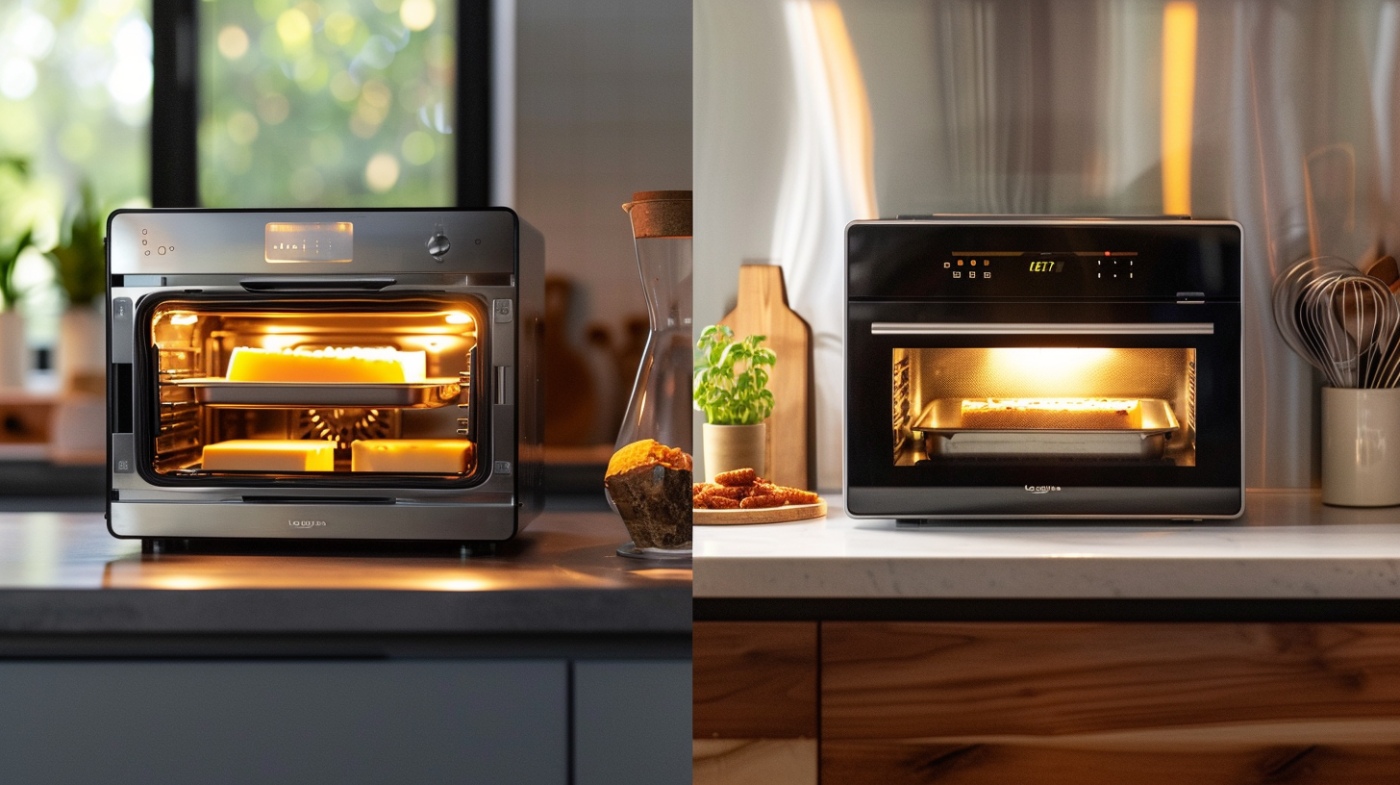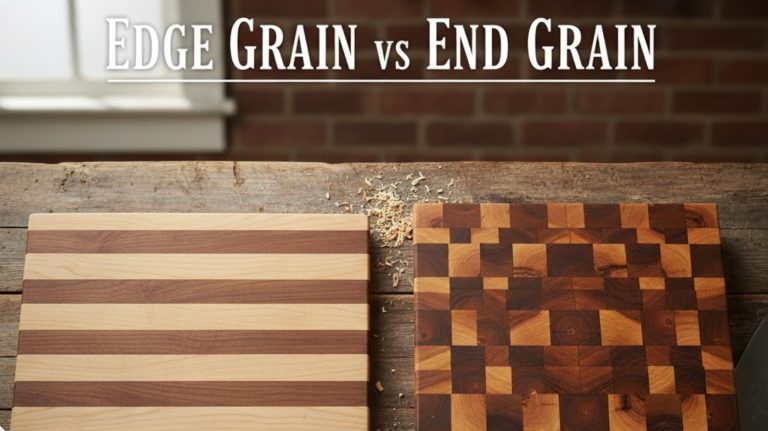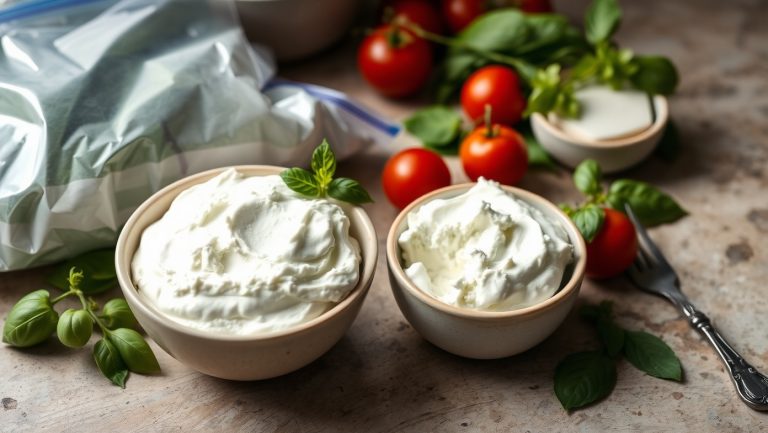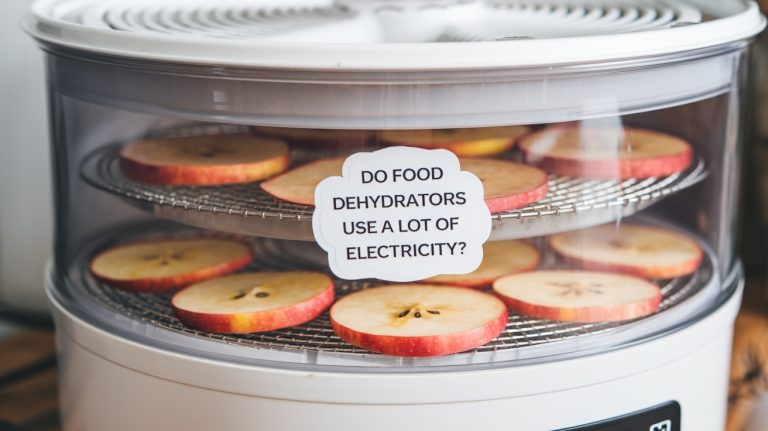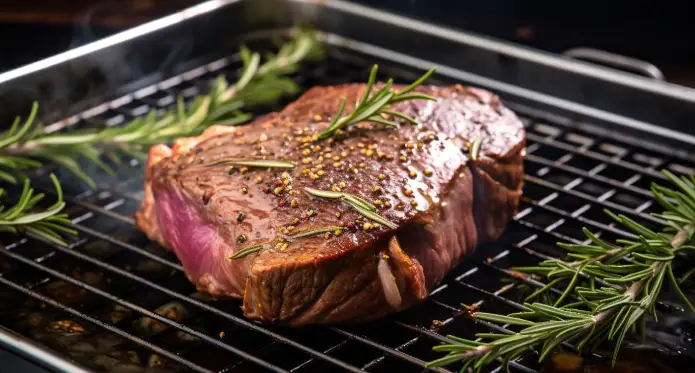Cheese Melter Vs Salamander: Identify the Best Fit for You
When choosing between a cheese melter and a salamander, you need to evaluate their distinct purposes. Cheese melters excel at melting cheese and finishing cheese-centric dishes, operating at lower temperatures around 600°F, which prevents burning. They’re compact and energy-efficient, ideal for smaller kitchens.
In contrast, salamanders provide versatile high-heat cooking with adjustable settings, perfect for broiling proteins and creating crispy finishes. They demand more space and cater to diverse menus.
Ultimately, your selection should align with your specific culinary needs. Continue on to uncover further insights into optimizing your kitchen equipment choices.
Key Takeaways
- Cheese melters are designed specifically for melting cheese, while salamanders are versatile, suited for broiling and finishing various dishes.
- Cheese melters operate at lower temperatures (around 600°F), ideal for gentle heating, whereas salamanders use high heat for quick cooking.
- Cheese melters typically have a smaller footprint, making them suitable for compact kitchens, while salamanders require more space for installation.
- The cost of cheese melters ranges from $3,000 to $5,000, whereas salamanders start around $4,000 but offer greater multifunctionality.
- For menus focused on cheese-heavy dishes, cheese melters are ideal, while diverse menus benefit from the versatility of salamanders.
Cheese Melters vs Salamanders: Things You Need to Know
Regarding kitchen appliances, understanding the nuances between cheese melters and salamanders can greatly enhance your cooking efficiency.
Cheese melters are specifically designed for melting cheese and finishing dishes, operating at lower temperatures ideal for tasks like toasting and warming. They employ top-mounted heating elements that deliver focused heat directly onto your food, ensuring perfectly browned cheese.
In contrast, salamanders are versatile cooking equipment capable of high-heat broiling and finishing a variety of foods. Their adjustable burners allow them to caramelize and broil, making them essential in high-volume commercial kitchens.
While both appliances share a similar appearance, the key difference lies in their intended use. Cheese melters excel in smaller kitchens for cheese-centric dishes like nachos and French onion soup, while salamanders serve broader culinary applications.
You’ll find cheese melters available in compact designs for countertop or wall-mounted installations, whereas salamanders often require more space due to their multifunctionality, with options for wall-mounting or installation above ranges.
Key Features of Cheese Melters
Cheese melters are indispensable for any kitchen focused on perfecting cheese-based dishes. They are available in electric and gas models, allowing you to select the best fit for your kitchen preferences.
Whether you opt for countertop models or wall-mounted units, cheese melters maximize available space while offering flexibility in design.
One of the standout features is their heating capacity, specifically tailored for precise cheese melting. This guarantees that your dishes, from pasta to French onion soup, always achieve the perfect texture.
Additionally, pass-thru models enhance workflow by facilitating efficient meal warming between the kitchen and service area, thereby improving speed and service quality.
Here’s a quick overview of key features:
| Feature | Description |
|---|---|
| Heating Type | Electric or Gas |
| Installation | Countertop or Wall-mounted |
| Primary Function | Designed to toast, melt, and warm food |
| Space Efficiency | Compact design for various layouts |
Main Features of Salamanders
When considering salamanders, you’ll appreciate their versatile cooking applications, from broiling to caramelizing.
Their adjustable heat settings grant you precise control, which is essential for achieving the perfect finish on various dishes.
Plus, with a larger cooking area, you can efficiently handle multiple items at once, making them ideal for busy kitchen environments.
Versatile Cooking Applications
Salamanders offer remarkable versatility in cooking applications, making them invaluable tools in any kitchen. Unlike cheese melters, salamander broilers are equipped with adjustable heating elements that provide precise temperature output, enabling you to master various cooking techniques such as broiling, browning, and caramelizing.
This adaptability allows you to prepare multiple dishes simultaneously, thanks to the cooking grate designed to accommodate a wide range of cookware.
Additionally, their high BTU output, typically ranging from 36,000 to 43,000, guarantees that you achieve consistent and powerful cooking performance for all your culinary needs, making them a great choice for the best salamander broilers.
With higher temperature ranges than cheese melters, salamanders excel in tasks that demand intense heat, like broiling steaks to perfection or finishing au gratin dishes with a golden crust.
Their design often permits easy wall-mounting or placement above cooking ranges, maximizing kitchen space and enhancing overall efficiency.
In high-volume commercial kitchens, the ability of salamanders to quickly cook and finish dishes becomes essential, especially during peak service times.
Adjustable Heat Settings
Adjustable heat settings are a standout feature of salamanders, allowing chefs to customize cooking conditions for a variety of dishes.
These settings let you control heat intensity across low, medium, and high temperatures, enhancing the versatility necessary for different food items and cooking techniques. Whether you’re broiling fish or caramelizing vegetables, having the right heat level is essential.
Many salamanders also include multiple heat zones, enabling you to cook various dishes simultaneously at different temperatures.
This feature is particularly beneficial in high-volume kitchens, where efficiency is paramount. The ability to adjust the distance between the food and the heating element further enhances precise heat management, granting you even more control over the cooking process.
Cooking Area Capacity
The cooking area capacity of salamanders is particularly superior to that of cheese melters, making them ideal for bustling kitchens. In high-volume environments, you often need the ability to prepare multiple dishes at once. Salamanders excel in this aspect, offering features that enhance efficiency and versatility.
- Adjustable cooking grate: You can position food closer to the heat source, optimizing the cooking process for various dish sizes.
- Larger cookware compatibility: Salamanders can accommodate larger pans and platters, essential for broiling and finishing substantial portions.
- Efficient heat distribution: The design guarantees even cooking and browning of multiple items simultaneously.
With a wider cooking area, salamanders allow you to maximize your output without sacrificing quality.
Their versatility in food preparation, combined with the ability to use different configurations and multiple racks, sets them apart in professional kitchens.
Whether you’re browning, broiling, or finishing dishes, a salamander’s superior cooking area capacity enables you to achieve consistent results while managing a fast-paced environment.
In contrast, cheese melters simply don’t offer the same level of functionality or space.
Applications of Cheese Melters
When you consider the applications of cheese melters, their efficiency in melting cheese is hard to overlook. They create a perfect, golden topping for dishes like nachos and French onion soup and provide versatile reheating options for various pre-cooked menu items.
This adaptability makes cheese melters an invaluable tool in busy kitchen environments, allowing you to enhance your offerings without occupying much space.
Melting Cheese Efficiency
Maximizing melting efficiency is essential for achieving the perfect cheese consistency in various dishes, and cheese melters excel in this regard.
Operating at lower temperatures, typically around 600°F, they gently melt the cheese without the risk of burning or overcooking. This precision makes them ideal for a variety of cheese-centric applications.
Here are a few key advantages of cheese melters:
- Focused Heating: They provide direct heat from above, allowing for quick melting and browning.
- Energy Efficiency: By applying heat directly to the food, they reduce cooking times and lower energy consumption compared to traditional ovens.
- Versatile Applications: Cheese melters are perfect for dishes such as nachos, French onion soup, and toasted bread.
In contrast, while salamanders are effective, they often require more extensive preheating and higher temperatures, which can lead to uneven results.
Versatile Reheating Options
Cheese melters shine in melting cheese and offer versatile reheating options that enhance kitchen efficiency. These appliances are perfect for reheating pre-cooked items like pizza and bread, allowing you to serve warm dishes without the risk of overcooking.
Unlike salamanders, which can apply higher heat for quick tasks, cheese melters provide a gentler approach, ensuring your food retains its quality. You’ll appreciate how cheese melters excel at toasting bread for sandwiches and appetizers, delivering even browning and a crispy texture that elevates your dishes.
Additionally, they’re fantastic for keeping plates warm post-plating, enhancing both the presentation and temperature of your meals. Their compact design fits seamlessly into various kitchen layouts, making cheese melters suitable for smaller spaces while still providing versatile reheating solutions.
With options for electric and gas models, you can choose the installation that best suits your operational needs, whether in busy commercial kitchens or smaller setups.
Applications of Salamanders
The versatility of salamanders makes them indispensable in high-volume kitchens, where efficiency and precision are paramount. Salamanders are often used to broil meats like steaks and chicken, allowing for quick cooking without sacrificing quality.
Their adjustable heat settings provide chefs with the ability to control cooking processes precisely, accommodating various techniques and food types.
Here are some key applications of salamanders:
- Broiling: Perfect for quickly cooking proteins and achieving a crispy exterior.
- Finishing Dishes: Ideal for browning casseroles or gratins, enhancing both flavor and presentation.
- Heating Cast Iron Platters: Maintains the temperature of dishes until service, ensuring a quality dining experience.
Salamanders excel in handling multiple tasks, making them essential for busy commercial kitchens that require efficient cooking solutions.
Purchase Considerations of Cheese Melters and Salamanders
When considering your options for kitchen equipment, it’s important to evaluate the specific functions you need to fulfill. Cheese melters are designed primarily for cheese-centric dishes, making them ideal if that’s your focus.
However, if you require greater versatility, salamanders can handle a broader range of cooking tasks, from broiling to toasting.
Next, assess your specific cooking needs and consider your kitchen space requirements. Cheese melters typically have a smaller footprint, making them easier to fit into compact kitchens. Salamanders, on the other hand, may require more room for installation due to their larger size.
Budget is another vital factor. Cheese melters are generally more affordable, providing a cost-effective choice for limited applications. In contrast, salamanders tend to be pricier but can justify the investment with their multifunctionality.
Choosing the Right Equipment
Considering your culinary needs is essential when selecting between a cheese melter and a salamander. Each appliance serves distinct purposes, so you’ll want to evaluate several factors before making a decision.
- Primary Function: Cheese melters excel at melting cheese and finishing dishes, while salamanders provide versatility for broiling and various cooking techniques.
- Kitchen Space: Cheese melters are compact, making them ideal for smaller kitchens. Salamanders, with their larger size and multifunctional capabilities, require more room.
- Budget Constraints: Cheese melters typically range from $3,000 to $5,000, while salamanders start at around $4,000 and can go higher depending on features.
When choosing, think about the heating requirements as well. Cheese melters operate at lower temperatures, perfect for delicate tasks, while salamanders deliver higher heat for broader cooking applications.
If your menu leans heavily on cheese-centric dishes, a cheese melter is your best bet. Conversely, if you need the flexibility to tackle a variety of cooking tasks, a salamander will serve you better.
Frequently Asked Questions
Why Is a Cheese Melter Called a Salamander?
A cheese melter’s often called a salamander due to similar heating elements and intense broiling capabilities. This interchangeable terminology stems from their shared functions in professional kitchens, leading to occasional confusion in culinary contexts.
What Is a Cheese Melter Used For?
You use a cheese melter primarily for achieving perfectly melted cheese on dishes like nachos or pasta. It’s also great for warming plates and lightly reheating pre-cooked items without risking overcooking or drying out.
Why Do They Call It a Salamander Oven?
The term “salamander oven” arises from its mythological namesake, symbolizing intense heat. Its design allows you to control cooking precision, making it essential for tasks like broiling and finishing dishes in professional kitchens.
Is a Salamander Broiler Worth It?
A salamander broiler’s versatility and precise temperature control enhance your cooking capabilities. Though the initial cost may seem high, its multifunctionality and efficiency can lead to significant long-term savings and improved dish quality in your kitchen.
Choose Your Culinary Champion Between Melters and Salamanders According to Your Needs
In the battle of cheese melters versus salamanders, choosing the right equipment can feel like deciding between a culinary rocket ship and a trusty steed.
While both have their merits, the cheese melter is your go-to for that molten, gooey perfection, while the salamander dazzles with its broiling prowess.
Ultimately, the decision hinges on your kitchen’s needs—pick wisely, and you might just transform your dishes into legendary creations that could make even the gods of gastronomy weep with joy.

